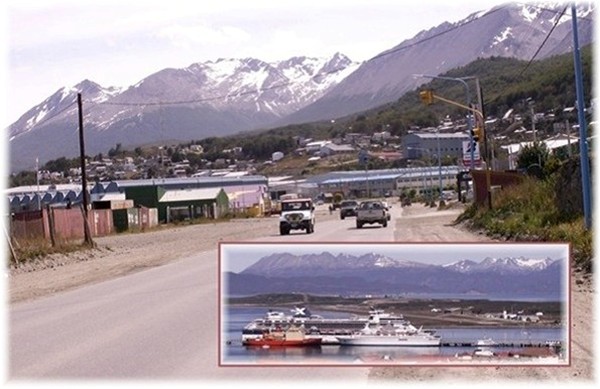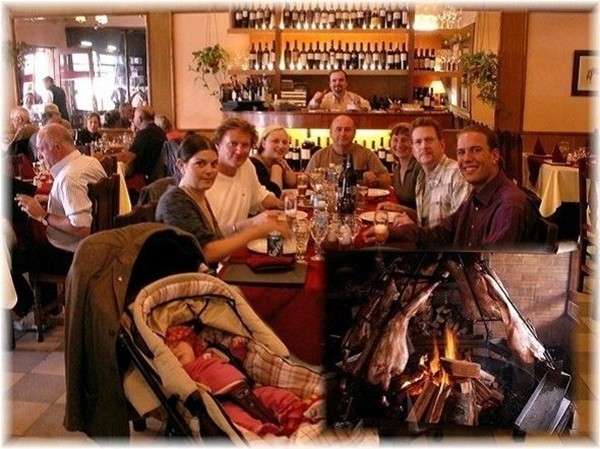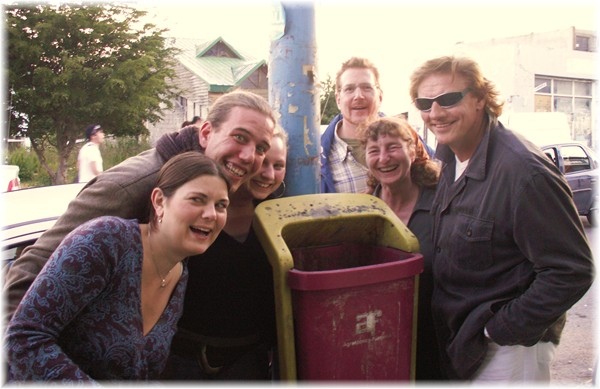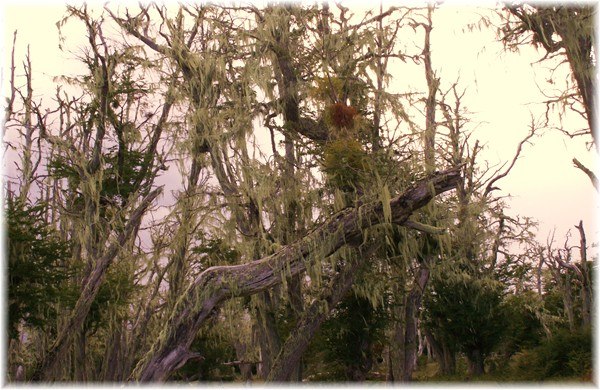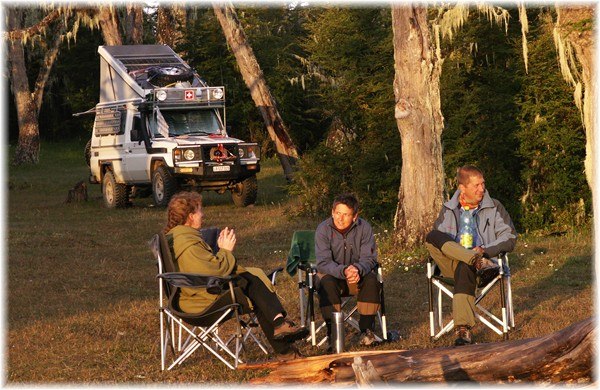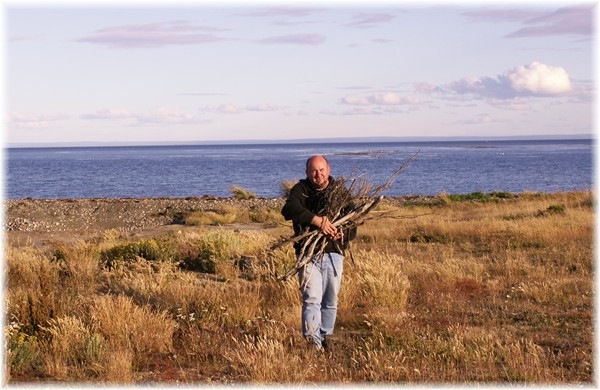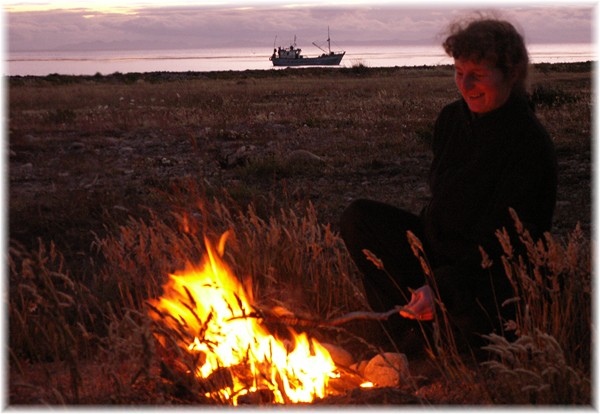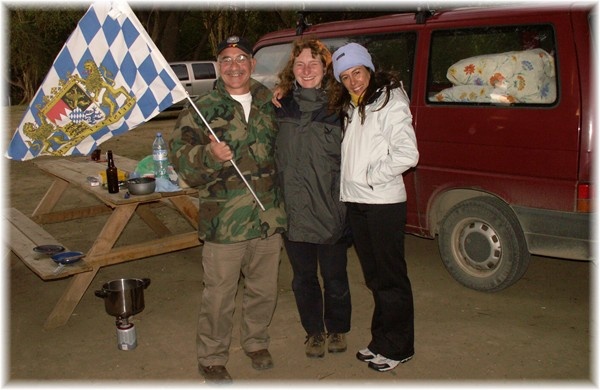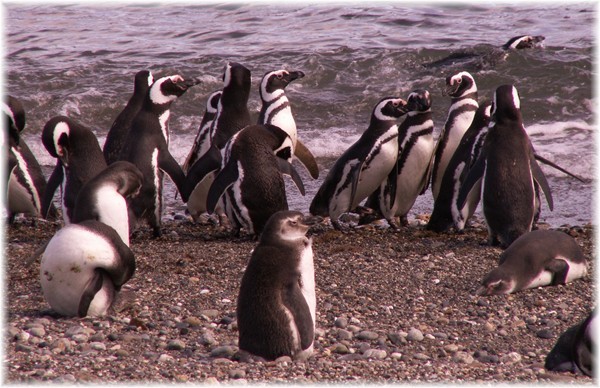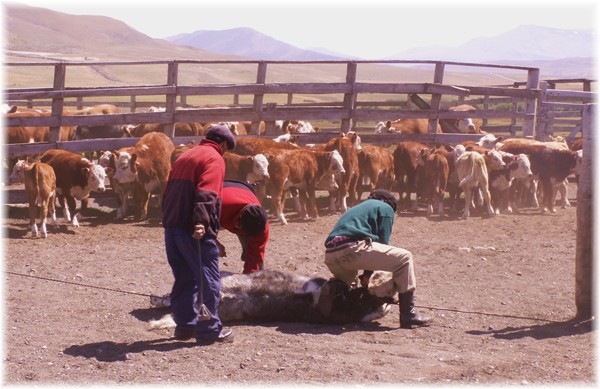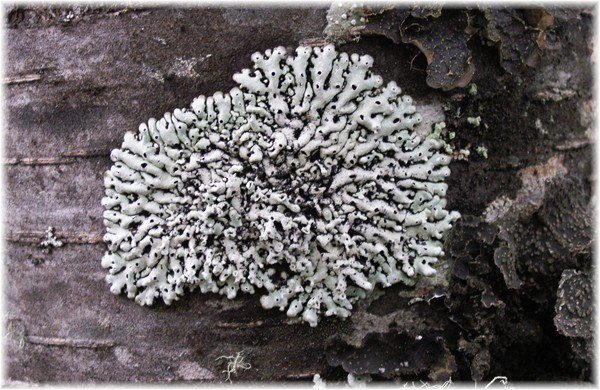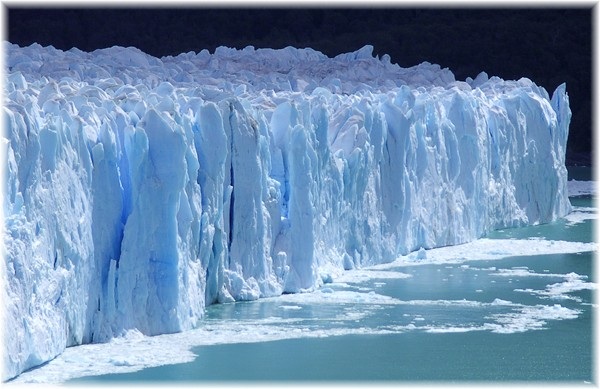Saturday morning: The Argentinean flag waves from the flagpole, it is quite ragged.. Finally we arrived the Argentinean – Chilenian border, we are near Tierra del Fuego. If you look onto the map for the first time, one could think that Tierra del Fuego is a peninsula of Argentina and Chile. In fact it is a huge island which is separated by the water street called Street of Magellan. The eastern part of the island belongs to Argentina, the rest of it to Chile. In order to come to Tierra del Fuego one have first to pass about 220 km through Chile – including a ships passage over the Street of Magellan – and then you are at the most southerly point of Tierra del Fuego in Argentina.
We are at the end of a long waiting line at the border from about 30 cars and a few lorries. In a small building there are four counter where all the papers get stamped to be allowed to leave the country Argentina. It takes ages till it is our time. After all is done we can go and we drive now through no man´s land to the border of Chile. As well this procedure needs quite a while. After we have again stamped all our papers to enter Chile, we are ready to go. That´s what we thought!! A person with dark sunglasses comes to our bus and want to see the bus. Not at all he is looking like someone working for the government. So I think, he is someone want to hitch-hike. Michaela opens the door and try to speak to him. In that moment I am ready to throw him out of the bus, Michaela realizes that he is from the food control and stops me to do so. By law it is forbidden to bring any veggies, fruits and meat into the country. Yesterday we bought fresh Tomatoes, these are now belonging to him. It took us about 3 ½ hour´s for the whole procedure at the border to leave and enter again. That means that we now already know what will come after the 220 km. But first we have to make it on a gravel road for the next 170 km.
Now we have to do the border control the other way round. Leaving Chile and then entering Argentina. But this time we need just half of the time. But still we can´t make our destination for today and so we decide to overnight near Rio Grande at the beach. We make our way through the dunes and — for only one minute I did not concentrate and we get stuck in sand till the axle. It is nearly night time and I think it over if we should not leave it until tomorrow. But Michaela wants to do it right away and so we start to work. Michaela get´s onto the roof of the bus, catches the sand metal plates and the spade. We do the work in turns: digging, sand metal plates under the wheels of the bus and this for about four turns. After 1 ½ hours the wheels of the bus are on hard soil again. We are tired and hungry but nevertheless we are just having a cold dinner instead of a warm one. Out of the fridge we get us a cold beer and after five minutes we laugh already about this “adventure”. After this long and boring rides through the Pampa, this day was really full of changes.
Since yesterday we are now on Tierra del Fuego. In an old guide, which I have bought 15 years ago for my first trip to South-America, it is written: “Tierra del Fuego – endless plain, lonely paradise and lot´s of space for dreams”. Well this is just partly true, “seclusion” is not like it have been 15 years ago. For example the small fishing “village” Usuhaia. About 6000 inhabitants did live here in 1975, where nowadays the population is 60 000 and it seems that there are coming more people to live here, since all over you can see construction sites for new houses. Additional during the summertime’s there are about 80 cruise ships getting into the harbour of Usuhaia with about 10 000 tourists coming, apart from the daily Tourist’s which arrive in buses and via airplane.
As well the MS Delphin, the ship on which Michaela did work, comes back from an Antarctic trip and be anchore for two days in Usuhaia. Michaela quickly arranged a meeting with a few colleagues from the ship and we go out for a fantastic dinner in an Asado-Grill-restaurant. From our table we can look onto the whole lamb which is roasting slowly over the wooden fire place
As well the huge beef steaks are tasting wonderful. A nightmare for all vegetarians but a paradise for those who love meat. The Argentinean people love to eat meat. In average they eat per year/ person 61 kg meat. In comparison the German people eat just 13 kg. Even we – normally not very fond of meat – eat since we are in Argentina quiet a lot of meat. The cost of a kilogram of a filet of beef is just 3 Euros.
We have a great evening with the colleagues of Michaela and in the end we have a few cans of beer which we drink on this wonderful Summer evening in the park of Usuhaia. This weather is unusual for this region. A day before we arrived here it snowed.
After Ushuaia we visit the Estancia Haberton and a small fishing village, named Puerto Almanza and then we try to find the “seclusion of Tierra del Fuego”. We drive away from the Routa National No. 3 and follow a gravel road for about 40 km. According to our map we should find here the lake “Lago Yehuin”. But – no lake to see, no signs, nothing. We think it over, if we should drive back, but since it is already late we decide to carry on. So we drive for a few more km and there it is, Lago Yehuin. A wonderful lake with crystal clear water. Far in the west we can see the glacier and the snowy mountains of the Darwin Cordillere. At the banks of the lake there is a hotel which has burned down. No human beings, no sole, nothing. Silence! It is quiet mysterious. In this moment one could believe that we are the only people on the whole earth.
The wind stops and the sun warms us up again.
Michaela hears some noise, from the direction, where we came from. But with so much silence one can fantasize. After a while, I can hear the noise as well. It is a jeep with Joli and Ingo. A couple which we have already met earlier on the campground in Usuhaia. With warm clothes and coffee and tea we sit together at the lake, speak about “God and the world” until the coldness gets us back into our cars.
In the morning we go separate ways again. Joli and Ingo want to stay a couple of more days and we want to go up north and then onto the Chilenian side of Tierra del Fuego. Shortly before the border we get more petrol and as well groceries, since the prices in Chile are about double as high then in Argentina. Since fruits, veggies and meat is not allowed to bring over to Chile we get them out of the fridge and into our Toilette (which we never used as a toilette but as a store). Now we do hope that the controller prefer to look into our fridge rather then into our toilette. Yes, this was right, he looks into our fridge and points onto our Toilette: Ah, el bano, muy bien (Ah, a toilette, great!)
Again over dusty gravel roads. We drive by at closed Minefields, which still remember the time of the “Almost war of 1978” The signs are even in German and English stating “Do not enter”. In those times there was starting a fight between Argentina and Chile, fighting for three tiny rocks on the coast of Tierra del Fuego. Both countries did state that they are the owners of it. In the year 1985 the pope was that one to settle the dispute by taking the advantage that both presidents have been very religious.
At sundown we arrive the coast where we stay overnight. Since here are no trees I collect flot-wood for our campfire.
There is enough of it at the beach. Meanwhile Michaela prepare the smuggled Argentinean meat. That´s the reason, today the meat tastes even better. Two fishermen, which are working on a fishing-ship be anchored, see the campfire and come on shore with a small boat. Even if there dialect is hard to understand for us and with our not to good Spanish, we have an interesting conversation. Certainly our dictionary is as well quiet useful. But both of them have to get up tomorrow morning early, so therefore they leave us after another hour again.
We say good bye to Tierra del Fuego. From Porvenir we take a small ferry, which brings us in
2 ½ hours over the Street of Magellan to the port of Punta Arenas. When we arrive the sky is full of clouds. The city of Punta Arenas has as well the name of “Gate to the Antarctica”. Out of this port lot´s of cruise ships leave during the South-Summer month to the 6th continent. Punta Arenas with a population of 120 000 is not really an attractive city.
Our way leads us towards the national park of Torres del Paine. On our way we make a stop at a small colony of Magellan-Penguins, which take their name from the Street of Magellan where they live. When it gets winter-time they make their way to Brazil.
We flee as well towards the North in the hope that we will get warm weather and the storm will become just wind. At a place called Cerro Castillo we have the possibility to watch Gauchos (the cowboys of South-America), how they brand the young cattle.
They get them with a lasso and two Gauchos are holding them. Then a red hot sign from the various Estancia gets stuck on there back side.
Because of the storm, which always gets us dust in the eyes we leave this place. The storm is now more like a hurricane. The door to our bus is nearly not to open, honestly!! Once we are in the bus we are secured. Who ever has to go now out for any necessary things, should think it over twice. The wind (?) comes from all over.
Just in the evening, once we arrive at the Torres del Paine it gets a bit better.
Already on our way to the National park we can see lots of herds of Guanakos and Nandus, the South American ostrich. Three condors are up in the sky and a small group of Flamingos are walking on the shore of a small lake. There are as well Pumas in this Park, but to see one of those it is quiet unusual. We overnight at a place where it is allowed to camp and have a terrific view up to Cuernos del Paine, a huge mountain range and the heart of the national park.
In the evening it gets quiet cool, so we decide not to cook outside. We have cold kitchen and go to bed early under our warm blanket, dreaming about a good trekking weather for tomorrow. Well the weather seems not to get better, the weather forecast is rain, mist and more wind, so we decide after three more days to leave and go further back to Argentina.
We are now on the Cuarenta ( Routa National No. 40) direction north through the Patagonian Table mountains until El Calafate. Then a side street to the glacier Perito Moreno The Patagonian inland ice field with its glaciers is the biggest ice field of the world, after the ice fields of the poles and Greenland. About 30 m far away from the glacier we can watch ice rocks of the size of a house falling into the Lago Argentina with enormous noise. It is fantastic so see this and we are for a long time here, watching it.
Here we meet Petra and Richard again which are from Schrobenhausen (Bavaria) and are in Argentina and Chile for 3 month in there VW-bus. We already met them in the National park Torres del Paine.
All together we drive to Lago Roca, where we stay for a couple of days. The daily highlight is the campfire in the evening with temperatures nearly to cero degrees Celsius. When we are cooled out, the only thing which helps, once we are back in our buses, are hot water bottles and the heater.
During the night we hear a noise now and then and we know this is not a thunderstorm but ice rocks falling into the Lago Argentino. Then we even get deeper into our warm blankets.
That was it for this time.
Michaela and Raimund




